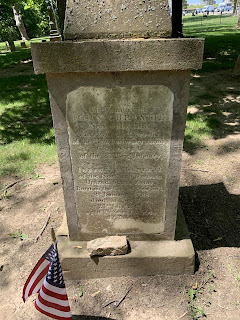John and I made a trip to Quebec in the spring and stopped off in Prescott along the way. We visited an amazing little pioneer museum before walking across the street to the Kenyon Cemetery. This stone caught my eye because it was for two people who may have been married and died decades apart. I decided to focus on Edward first.
Edward Duncan MacGillivray was born to parents Murdoch and Kate Mc Rae on 18 November 1896 in Prescott, Ontario, and named after his paternal grandfather.(1)(2)
He appears in the 1901 census with his parents and younger sister Mary. Murdoch is 50 and Kate is 34.(3)
In 1911, Edward is still with his parents, along with Mary and younger siblings Rory, Nora, Flora Ann (born June 1896), Hector M. D., and Christy Ann.(4)
On 11 June 1918 he has his medical exam in Ottawa and is approve for military service. His birthplace is recorded as McCrimmon, Ontario and he's a single farmer and living in Dunvegan, presumably with his parents. He was 5' 7.5" with a dark complexion, dark brown hair, and blue eyes. He had a brand on his left breast. His unit was the 2nd Depot Battalion, Eastern Ontario Regiment.(5)
Edward returns home and is back with his parents and all of his siblings with the exception of Mary in the 1921 census.(6) Little seems to have changed by 1931, Edward, Rory, Floraann, Hector and Christina are all still living with their parents. Seems kinda odd that no one is really leaving. Edward can speak Gaelic in addition to English.(7)
Sadly Edward died after 14 days of influenza and 10 days of meningitis. His brother Roderick (Rory) reported his death.(8)
Influenza strikes again and Murdoch died a few years later on 26 December 1936 of influenza with myocarditis as a contributing factor. Murdoch was born in Ontario as were his parents Edward (born in McCrimmon,County Lochiel) and Mary MacIntosh (born in Dalkieth, County Lochiel)(9)
I wasn't able to find an obituary for Edward or Murdoch.
I was able to undercover several obituaries for his siblings and his mom, starting with sister Flora Ann, who shares his grave. Flora Ann's obituary appeared in the Ottawa Citizen on 31 March 2006 (page 51). She passed away at Maxville Manor and there was no reference to a spouse or children. The obit does reveal some details about her siblings, which helped me uncover more obituaries. She seems to have outlived them all and was predeceased by brothers Edward, Rory and Hector and sisters Mary Sheldrick, Christina Hewston, and Nora Irwin (Irvine).
Katie died 27 July 1959 at Cornwall General Hospital. Her obituary names her parents, Roderick F MacRae and Nora Bethune and explains that she married Murdoch on 19 September 1895. She was well known for her charity and was a charter member of the Women's Institute and a life member of Skye W.M.S.(10)
Rory died suddenly on 6 May 1967, leaving behind his wife Penelope (nee MacLeod), and children Dr Royce MacGillivray of London England and Wilma Hayes of Ottawa, and grandson Steven Hayes. Hector was living in Brockville, Christina in Dunvegan, Mary in Vars, and Nora in Charlottetown PEI. (11)
Hector Donald Murdock MacGillivray died on 8 December 1972 in the Kingston General Hospital, following a few weeks of illness. Hector was an engineer, a member of Brockville Legion and Bayview Hunt Club. He had recently remarried to a woman named Edna Bland, his first wife Victoria MacMillan died in 1969. In his obituary we come to learn that Mary died about 5 weeks before him on Nov 1.(12)
Mary passed away in 1972. Sadly, her only son Keith passed away in an accident while fishing with a friend in 1954.(15)
Christina died 29 January 1985 at the age of 74. She was married to Clifford Hewston, lived in Avonmore. and had one surviving child, Garry. Her daughter Mrs Daryl Lang and son Orvil predeceased her. She had 4 grandchildren at the time of her death. Flora Ann was living in Alexandria and Nora was in Kingston. (13)
Nora passed away 29 June 1999 in the Ajax-Pickering Hospital and was buried in Kingston. There was no mention of siblings.(14)
(1)Archives of Ontario; Toronto, Ontario, Canada; Series: Registrations of Births and Stillbirths, 1869-1913; Reel: 134; Record Group: Rg 80-2
(2)
(3)Year: 1901; Census Place: Caledonia, Prescott, Ontario; Page: 8; Family No: 57
(4)Year: 1911; Census Place: 9 - Caledonia, Prescott, Ontario; Page: 1; Family No: 8
(5)Library and Archives Canada; Ottawa, Canada; Soldiers of the First World War (1914-1918)
(6)Reference Number: RG 31; Folder Number: 83; Census Place: 83, Prescott, Ontario; Page Number: 2
(7)Library and Archives Canada; Ottawa, Ontario, Canada; Seventh Census of Canada, 1931; Folder Number: T-27290; Census Place: Prescott, Ontario, Canada; Page Number: w
(8)Archives of Ontario; Toronto, Ontario, Canada; Collection: MS935; Reel: 449
(8)Archives of Ontario; Toronto, Ontario, Canada; Collection: MS935; Reel: 564
(9)The Ottawa Citizen, 31 Jan 1985, page 8
(10)https://www.findagrave.com/memorial/181537994/catherine-mcgillivray
(11)The Ottawa Citizen 8 May 1967, page 30
(12)https://www.findagrave.com/memorial/182826559/hector-donald_murdock-macgillivray
(13)The Ottawa Journal 02 November 1972, page 54
(14)The Kingston Whig 30 June 1999 page 38
(15)The Ottawa Citizen 23 June 1954 page 1



